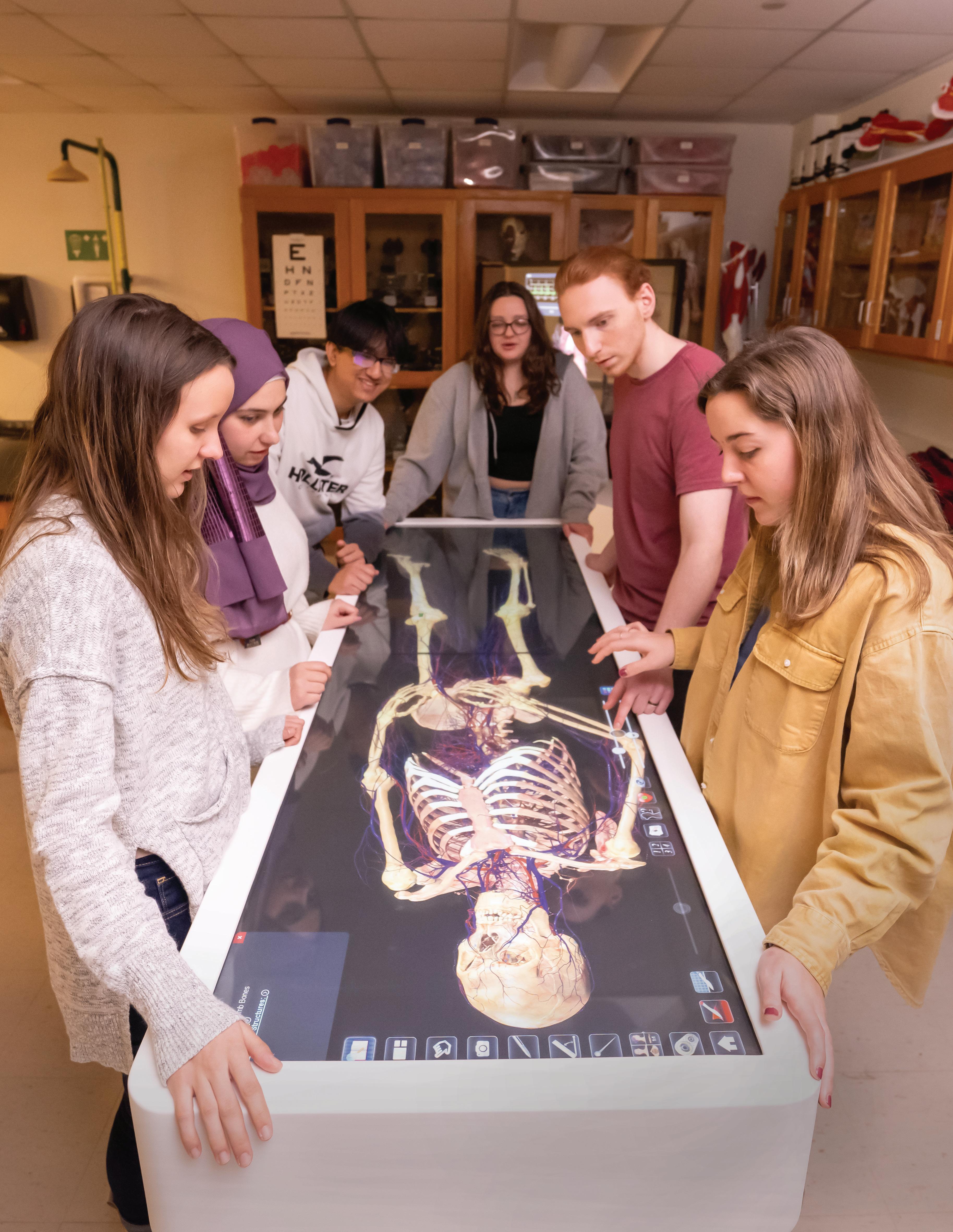
PENN STATE BEHREND SCHOOL OF SCIENCE SPRING/SUMMER 2023 6 Virtual Dissection Tables Offer Realistic Experience 5 Sigma Xi Research Conference Going Strong for Three Decades 8 Outreach Programs Expand School’s Reach 10 Faculty Members Answer Our Weird Science Questions 12 Mark Your Calendar for 2024 Eclipse Event SCIENCE NEWS
DIRECTOR’S MESSAGE

Science is about engage ment. It’s about doing, interacting, and communicat ing. Whether it’s a student in the classroom, a researcher in the field, or a visitor to our school, engagement is a hallmark of the School of Science.
The most effective learning is not passive but active—with students not only listening to someone talk about subject matter but also engaging with it. This could mean diving into the human body using our new Anatomage dissection tables or providing data to a global surveillance program dedicated to protecting salamanders from deadly fungal pathogens.
Much scientific research requires engagement with the world around. This could involve investigating invasive species on Presque Isle in the present day or turning back the clock to discover how shark spe cies evolved millions of years ago. There's no better way to communicate this research, exchange ideas, and engage with science colleagues than through a research gathering, such as the Penn State Behrend-Sigma Xi Undergraduate Research and Creative Accomplishment Conference hosted by the School of Science.
For many of us, our roles as scientists extend beyond the classroom or laboratory, as we reach into the community to pass on our enthusiasm and love of science. Whether participants are hunting for prehistoric eggs, exploring “scary” science, or using basic physics to keep from getting all wet, such engagement lights the spark in future generations of scientists.
As you read this issue of Science News, I hope you gain an appreciation for all the great engagement going on in the School of Science. Enjoy.
In Brief
finish line.
This past fall, the School of Science hosted a series of events to break the tension. Stress Less in the Science Complex featured three days of opportunities to take a breather with rescue dogs from the Erie Humane Society, dark sky relaxation programming in Yahn Planetarium, and virtual reality experiences, including immersive stress relief exercises, in VAR Edu. There’s nothing like petting a pup to release a few feel-good hormones and bring a smile to the faces of even the most stressed students.

CLIMATE CHANGE IS EVERYONE’S PROBLEM.
Penn State Behrend once again participated in the Worldwide Teach-In on Climate and Justice in March The program, which originated at Bard College, is designed to broaden discussion of climate-related issues, framing them through other disciplines, from psychology and global studies to investing and sustainable engineering.
“Climate change is not just a problem for scientists,” said Dr. Sherri “Sam” Mason, director of sustainability at Penn State Behrend and local coordinator of the event, which was staged in fifty countries around the world. “We’re all facing this problem, and we can all be part of the solution.”

 DR. MARTY KOCIOLEK
ON THE COVER : Students in BIOL 164 Human Anatomy and Physiology examine a cadaver on one of Behrend’s new Anatomage virtual dissection tables.
DR. MARTY KOCIOLEK
ON THE COVER : Students in BIOL 164 Human Anatomy and Physiology examine a cadaver on one of Behrend’s new Anatomage virtual dissection tables.
2
PATHOGEN DETECTORS
Students get valuable field experience while helping scientists. The best way to protect a species from harmful pathogens is to reduce the odds that a pathogen is transmitted. Once one is found, biologists need to act quickly to defend species and ecosystem health. In nature, however, early detection is inherently challenging, requiring geographically broad and ongoing surveillance. That’s why some organizations committed to conservation and protection have turned to future scientists for help.
This past fall, students in Dr. Lynne Beaty’s Ecology class participated in the Student Network for Amphibian Pathogen Surveillance (SNAPS), a network of students, scientists, and educators working to keep tabs on emerging pathogens in amphibians. An initial focus is on Batrachochytrium salamandrivorans (Bsal), a deadly fungus that has yet to be found in North America, but is currently ravaging salamander populations in parts of Europe. Given the high likelihood that Bsal will come to North America, a global
hotspot for salamander diversity, early detection is essential.
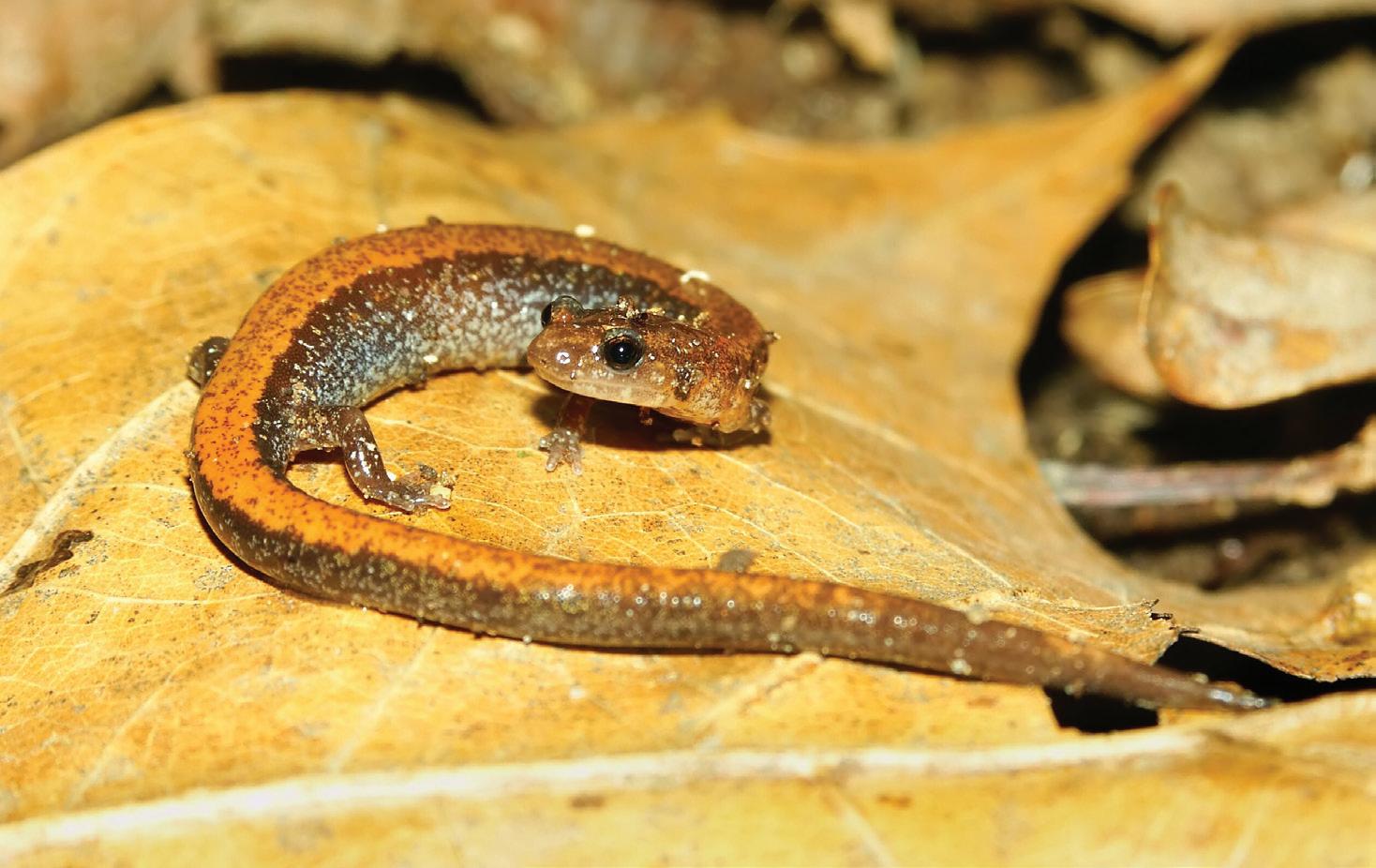
Sampling for Bsal is a simple procedure that involves swabbing the skin of amphibians, making it an ideal activity for scientists-in-training. SNAPS provided the supplies and protocols for sampling and biosecurity, and students got hands-on
LEARN THE SCIENCE OF WINE
Are you interested in food science? Mazza Vineyards in North East, Pennsylvania, is currently hiring for a full-time student co-op or internship experience in enology, the study of wines. The co-op will involve full-time summer/fall or spring/summer employment. Students can earn college credits and gain valuable training while being employed full-time at Mazza Vineyards. Participation in the co-op will result in a Penn State degree and employment experience in enology, fermentation, and the wine industry. For more information, email mac17@psu.edu.
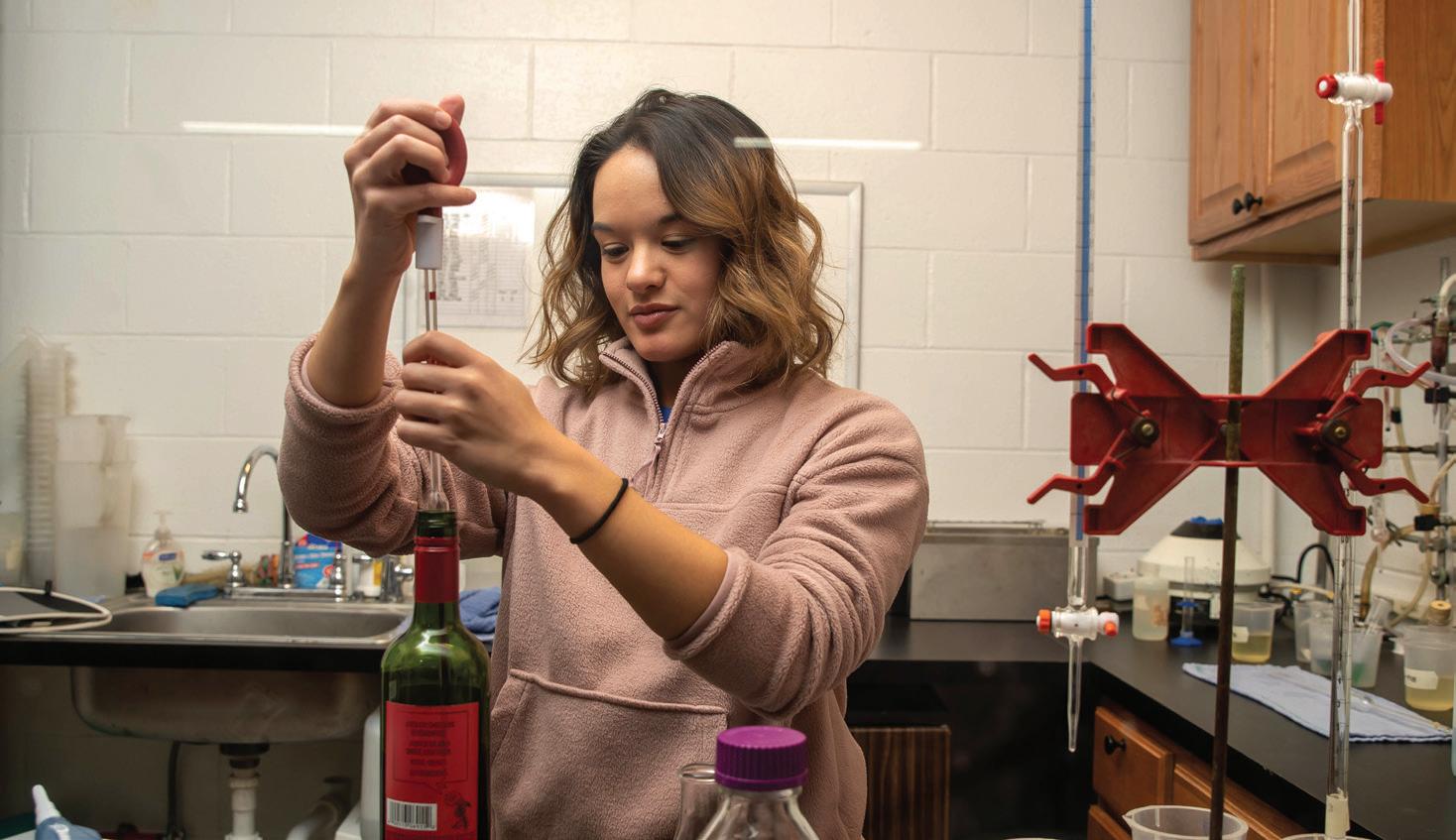
experience. The activities performed for this lab were approved by Penn State's Institutional Animal Care and Use Committee.
Penn State Behrend was one of just two schools in Pennsylvania to participate, and Beaty hopes to continue in future ecology and herpetology classes.
FACULTY & STAFF NEWS
NEW FACULTY
Dr. Sayali Phadke was hired as assistant professor of statistics. Dr. Derek Hanely was hired as assistant professor of mathematics. Maarten Van Hees was hired as a lecturer of physics.
PROMOTIONS
Dr. Blair Tuttle was promoted to professor of physics.
HONORS AND AWARDS
Dr. Lynne Beaty, assistant professor of biology, received the Council of Fellows Excellence in Teaching Award.
RETIREMENTS
Dr. Bruce Wittmershaus, associate professor emerita of physics, retired in May 2022.
3
In Brief
IN SEARCH OF SNAILS
Three Behrend biology faculty members, Dr. Lynne Beaty, Dr. Sam Nutile, and Dr. Adam Simpson, were recently awarded $115,000 from Pennsylvania Sea Grant to study invasive snails at Presque Isle State Park. Their research study is one of six projects addressing aquatic ecosystem and watershed challenges that were awarded a collective $1.07 million through 2024.
“Pennsylvania Sea Grant’s competitive research program supports researchers and students investigating critical ecological and economic issues impacting communities and waters across the Commonwealth,” said Dr. Sean Rafferty, research director for Pennsylvania Sea Grant. “This research support has the potential to produce solution-based results that contribute to enhanced water quality and natural resource management strategies in Pennsylvania.”
According to Beaty, the faculty members’ preliminary work has shown that Presque Isle State Park is now home to two invasive freshwater snail species—Bithynia tentaculata and Cipangopaludina chinen sis—that may threaten the native ecosystems in a number of ways.

The Pennsylvania Sea Grant College Program, which is administered by Penn State Behrend, is part of a network of thirtyfour Sea Grant programs dedicated to the protection and sustainable use of marine and Great Lakes resources.
Outside-in or inside-out?
Scientists have long debated the origins of teeth. Did they evolve from body scales that migrated into the mouths of ancient vertebrates and became adapted for eating—an idea known as the “outside-in” hypothesis? Or did they evolve independent of scales, originating deep within the oral cavity and ultimately mounting onto the jaws—known as the “inside-out” hypothesis? A new study led by Dr. Todd Cook, associate professor of biology, provides evidence for the “outside-in” hypothesis.
According to Cook, the research team, which included students Jack Prothero and Michael Brudy, did not set out to contribute to the debate about the origins of teeth. Instead, he and his colleagues were studying the tissue structure of ancient rostral denticles, the jagged spikes that run along the elongated snouts of sawsharks and sawfishes and are used in foraging and self-defense.
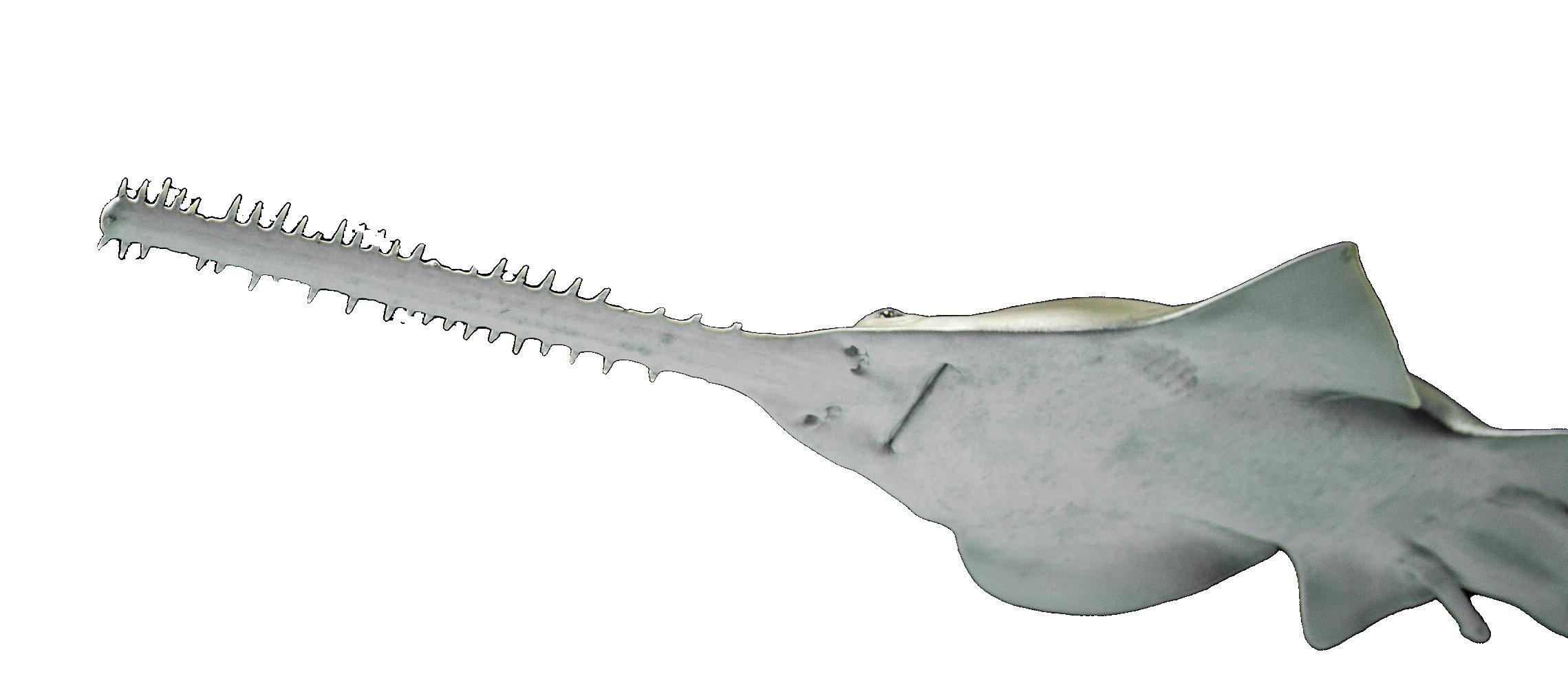

The team examined the fossilized rostral denticles of Ischyrhiza mira, a species belonging to an extinct group of sawfishes that lived in North American waters during the late Cretaceous period, around 100 to 65 million years ago. The samples had been recovered from a rock formation in New Jersey.
“Rostral denticles are believed to be modified scales because of their location
scales found elsewhere on the body, for a new denticle to form, an old one must first fall off to make a space available.
The study makes an important contribution to the long-standing debate about the origin of teeth. The rostral denticles have a similar tissue organization as the teeth of modern sharks. This finding provides “direct evidence supporting the ‘outside-in’ hypothesis, as it shows that scales have the capacity to evolve a complex tooth-like enameloid outside of the mouth.”
The team’s discovery was featured in
Dr. Todd Cook, associate professor of biology, is a vertebrate paleontologist who studies ancient sharks and rays from the Paleozoic and Mesozoic eras in North America, North Africa, and Australia.
Photo credit: Smithsonian Environmental Research Center, CC BY 2.0, via Wikimedia Commons
4
Meeting of the Minds
Undergraduate student research conference encourages inspiration and exchange of ideas
In the sciences, learning happens beyond the classroom and even beyond the lab or field. Insights and ideas often come from scientists sharing and discussing research findings.

For more than thirty years, Behrend has encouraged an exchange of insights among undergraduate students and faculty members through the Penn State Behrend-Sigma Xi Undergraduate Research and Creative Accomplishment Conference.
The event, held annually in April, brings together undergraduate science students from across northwestern Pennsylvania to give oral or poster presentations on the research they have been conducting.
Sigma Xi is an international, multidisciplinary scientific research honor society with more than 500 chapters in North America. Behrend works with the northwestern Pennsylvania chapter of the society to present the conference. Last year, nearly 150 undergraduate students from colleges and universities across the region presented their work, with eighty faculty members serving as judges.
In 2022, student research projects ranged from “Gender Differences in Anxi-
ety Levels Following Covid-19 Isolation” to “Population Genetics of Spotted Salamanders” to “Examining Which Exoplanets are in Their Habitable Zone” to “Detection and Analysis of Nanoplastics in Presque Isle Bay.”
“Often the work they present is for a research class credit, but it does not have to be,” said Dr. Jay Amicangelo, a professor of chemistry at Behrend and current president of the local Sigma Xi chapter. “The specific projects they work on are most often done in conjunction with a faculty member and, therefore, often represent the overall interest of the faculty adviser, though that’s not always the case.”

Not only does the conference give sci-
entists a chance to learn and be inspired by the work of one another, it also gives students the opportunity to develop their communication skills by presenting their research findings in a professional setting.
“They also get feedback on their project from other faculty members in their fields, which can be helpful if they are planning to continue the project in the future,” Amicangelo said. “And they can add it to their résumés as having participated in a professional activity.”
This year’s conference is scheduled for Saturday, April 22, and it is open to the public. For more information, visit behrend.psu.edu/urc.
5
Dr. Jay Amicangelo, professor of chemistry and president of the Northwestern Pennsylvania chapter of Sigma Xi, an international scientific research honor society, recently accepted a Chapter Program of Excellence Award in recognition of the group’s work on the undergraduate research conference held annually at Behrend.
Cutting-Edge Technology Offers Endless Lessons
Virtual dissection tables allow 3D exploration of cadavers, animal specimens
Cadaver dissection is a vital exercise for those planning careers in medicine and other health care fields, but it’s an experience that few undergraduate students get to have.
“Cadaver labs are hard to get and difficult to maintain,” said Dr. Todd Cook, associate professor of biology.
Now, Penn State Behrend students can gain experience in dissection without even getting gowned and gloved. Three new state-of-the-art Anatomage virtual dissection tables provide 3D renderings of digital cadavers, giving students the opportunity to digitally view, cut, and alter the orientation of the cadavers.
“These sophisticated teaching tools are found in many medical schools, but in few
undergraduate institutions,” Cook said, “and we have three of them—a full-size table and two clinical tables.”
The tables allow students to see anatomy exactly as it would be on a fresh cadaver. Users can choose from four different photorealistic cadavers that were recreated from actual human cadavers through serial sectioning of the bodies at 0.2 mm intervals and then imaging the sections. The anatomy is presented as a fully interactive, life-sized touch screen experience.
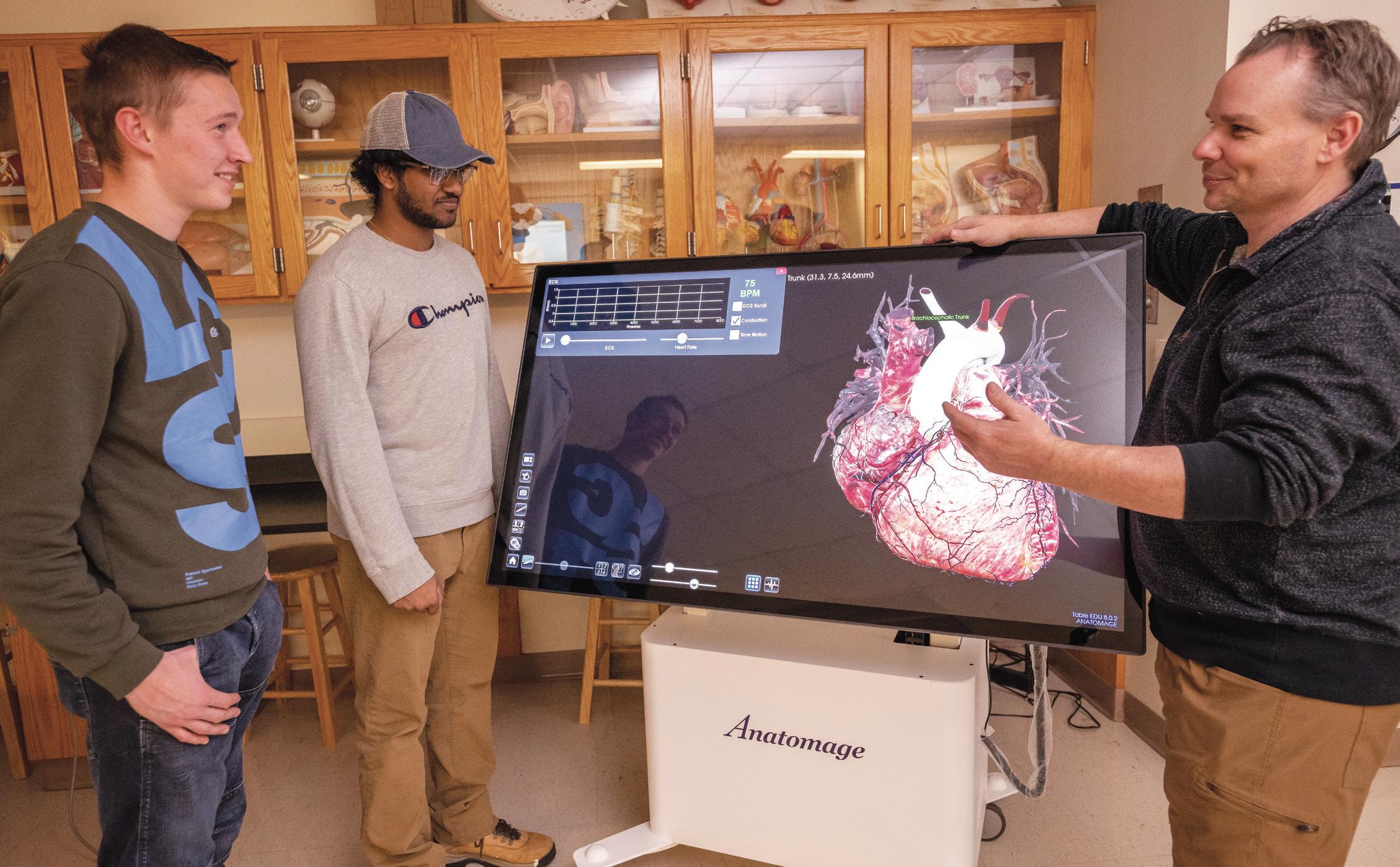
“The tables allow for limitless exploration and learning as the virtual specimens can be dissected repeatedly,” Cook said. “They also allow us to isolate for study systems of the body, such as the circulatory, endocrine, skeletal, and lymphatic systems. And we can even download
maladies for students to diagnose.”
The tables arrived over winter break and were quickly put to use in physiology and anatomy classes in the spring semester. They required little set up beyond plugging them in.
These virtual dissection tables aren’t just for learning by pre-health and nursing students, though. The smaller clinical tables include dozens of animal specimens in the same life-size, interactive format, which will be of use in many biology and science classes.
The Anatomage tables were made possible by a gift from the Orris C. Hirtzel and Beatrice Dewey Hirtzel Memorial Foundation.
6
“
The tables allow for limitless exploration and learning as the virtual specimens can be dissected repeatedly. They also allow us to isolate for study systems of the body, such as the circulatory, endocrine, skeletal, and lymphatic systems.
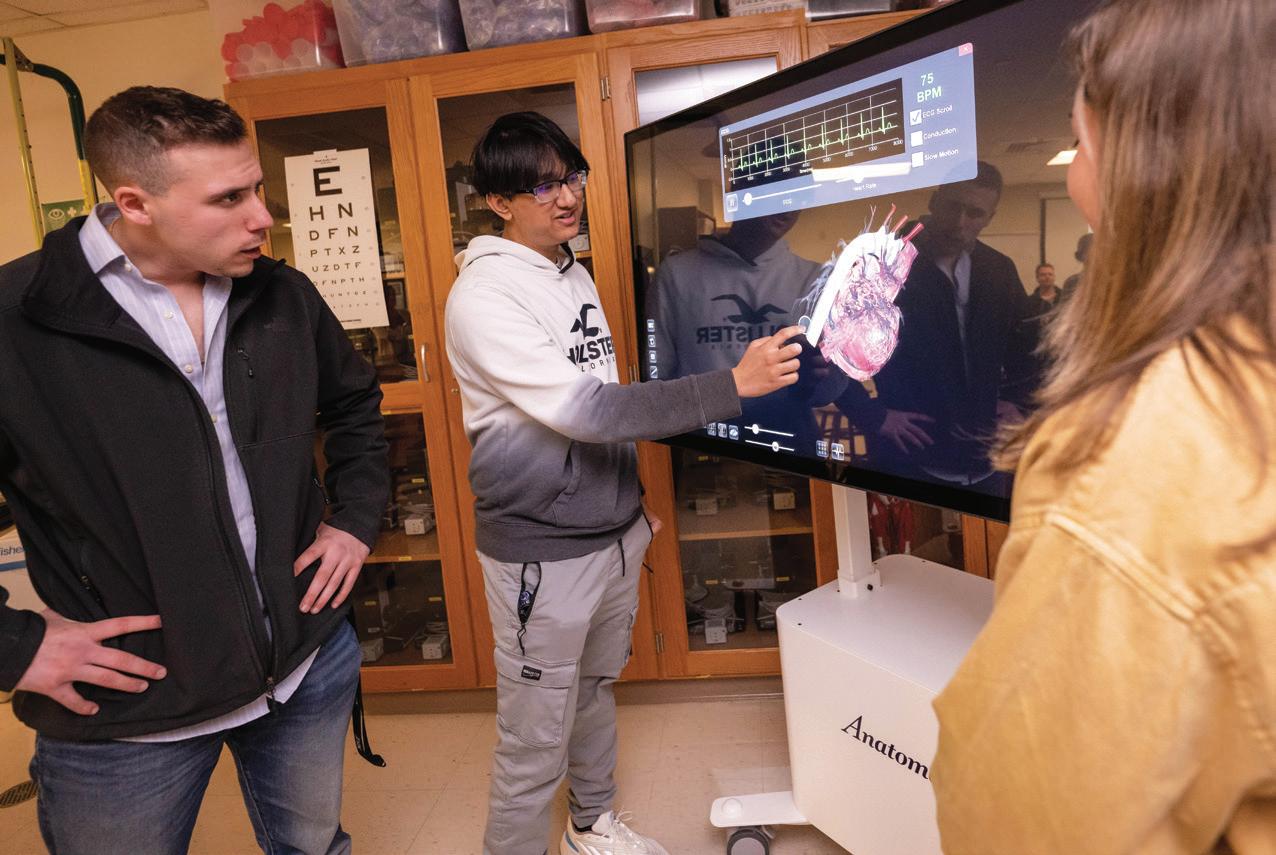
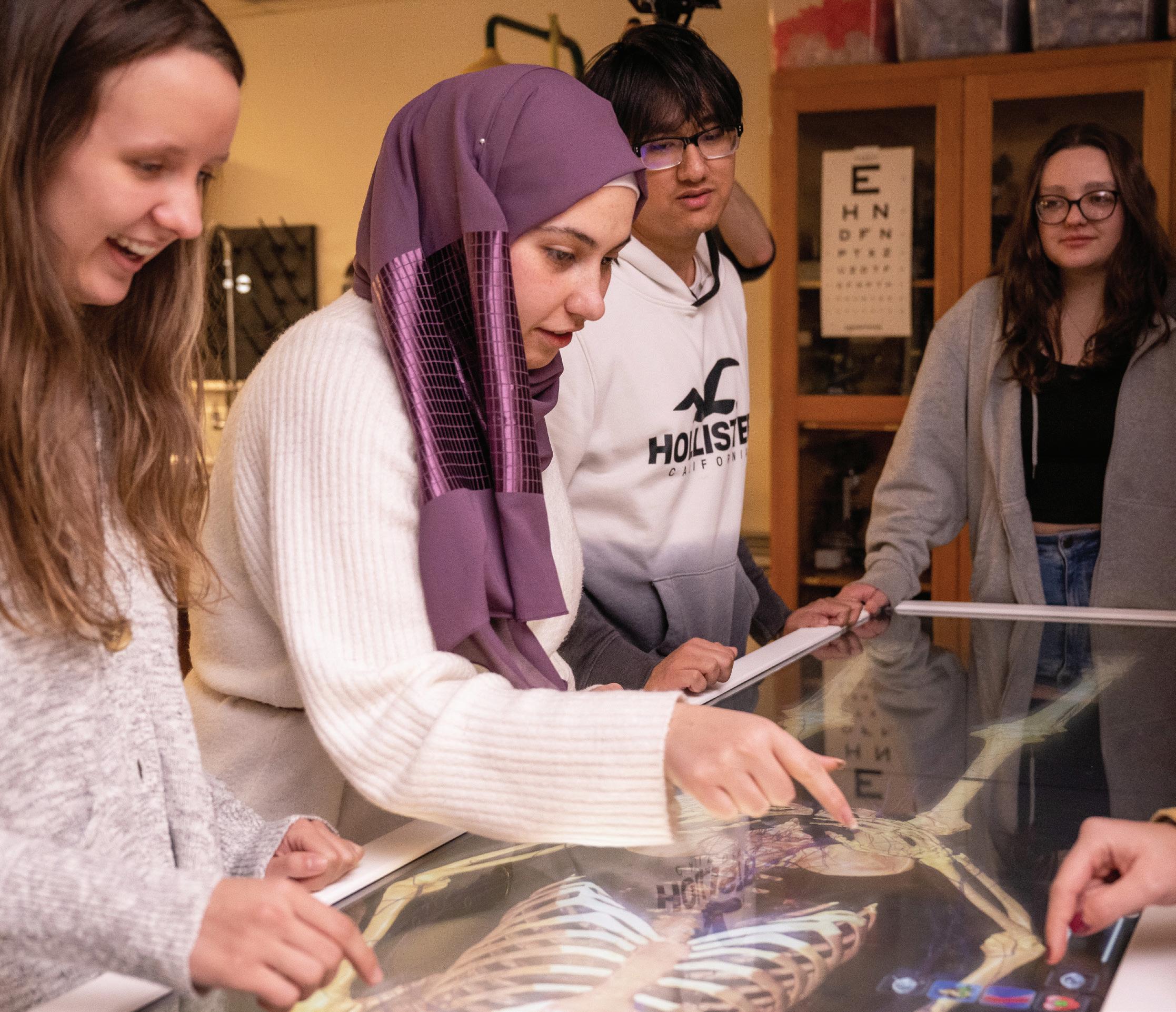 —DR. TODD COOK, ASSOCIATE PROFESSOR OF BIOLOGY
—DR. TODD COOK, ASSOCIATE PROFESSOR OF BIOLOGY
7
”
FUN WITH (THE SCHOOL OF)
Children are born scientists—from mastering the physics that is required to roll over to doing the math that ensures that they get the same number of cheese puffs as their siblings to observing a colony of ants or searching for fossils in a creek bed.
Young ones don’t know they are dabbling in the sciences, but their discoveries—often made through play—have all the ingredients of the scientific method: observation, hypotheses, and experimentation.
Somewhere between mud pies and middle school, kids may lose their love of science when it seems to become more work than fun.
But in Behrend’s School of Science, faculty members and students are committed to proving that science can be fun at any age with several new outreach programs for students from kindergarten to college.
These new events (detailed in the sidebar at right) are in addition to the school’s already-popular public outreach programs that include Astronomy Open Houses, Science Olympiad, Science Café presentations, and weekly Yahn Planetarium shows.
The school sees outreach as an investment in the future. “Science is the best way to teach kids how to think critically,” said Tracy Halmi, science outreach coordinator and associate teaching professor of chemistry. “Young people form opinions early. If we can get them excited about problem solving and science, it can inspire a lifetime of curiosity and learning so that they form educated opinions based on facts.”
School of Science outreach efforts are faculty-initiated and faculty-driven. “It’s a lot of work, but the smiles and bear hugs from kids make it all worth it,” Halmi said. “With many children, you can tell immediately you’re making a difference. Their faces just light up”.
Behrend students are involved and benefit from the programs, too. Not only do they get to share their passion for science with the next generation, they can practice their communication skills.
“It’s important that our students be able to communicate science to nonscientists,” Halmi said. “It’s a skill they will need in the real world, and they get experience doing it at these events.”
Dr. Beth Potter, associate professor of biology, has developed many new events, the COVID pandemic inspiring her to connect with the community.
“As scientists, we need to do a better job of communicating with the public so that they understand advances and new technologies when they are introduced,” Potter said. “We need to encourage everyone to think critically, like a scientist.”
Potter said events also encourage community involvement, which is important for students who may be planning to go to graduate school in the health care fields.
To that end, Potter created a 1.5-credit Science Service Learning Class—BIO 297—in the fall of 2022. Students enrolled in the class help plan and execute outreach events and other service projects.
“It really allows Behrend students to step into leadership roles and help mold the next generation of scientists by sharing their enthusiasm for it,” she said.
Yahn Planetarium has new public show hours Saturdays at 10:00 a.m. (kids show) and 11:30 a.m. (general audience). Visit behrend.psu.edu/ yahnplanetarium for presentation and ticket information.

8
OUTREACH PROGRAMS ENCOURAGE YOUNG PEOPLE TO DISCOVER
New Outreach Events

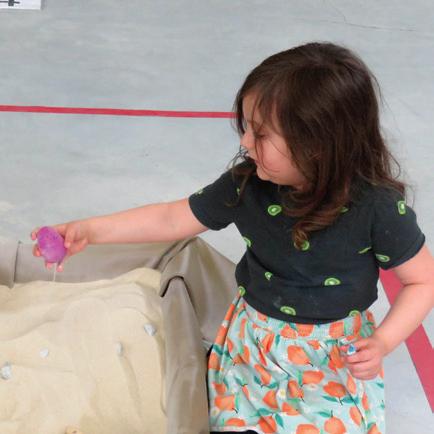
A Prehistoric Egg Hunt was aimed at elementary-school-age children, putting a scientific spin on the traditional Easter egg hunt. At the event, kids “excavated” eggs, looked for fossils in a “dig site,” and enjoyed dino-themed decorations, snacks, and games. They even had the opportunity to meet and talk to a real paleontologist—the school’s own Dr. Todd Cook, associate professor of biology.
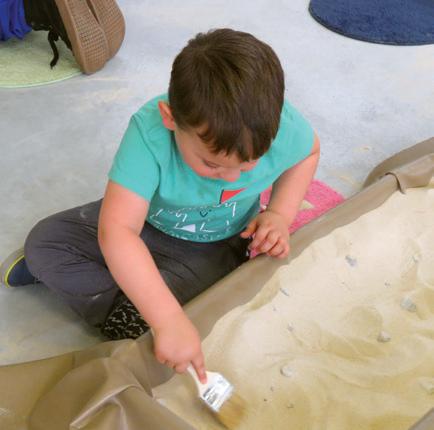
Boo-ology: The Haunting of Behrend’s Science Labs was a Halloween-themed event geared toward middle-school students. The premise: “There was once a mad professor who studied all things creepy and scary at Behrend. One Halloween night years ago, he went missing—never to return. For the first time, his abandoned, haunted lab will be opened to the public.” Attendees visited the mad professor’s pumpkin patch and extracted some DNA, used science to add ghosts to a graveyard, learned how to shake hands with an alien, and more.
For the Love of Darwin invited high school biology students to participate in hands-on workshops exploring Darwin’s theories of evolution and natural selection. Students examined the effects of mutations and selection by predation, and they got to try out the school’s new virtual dissection tables.
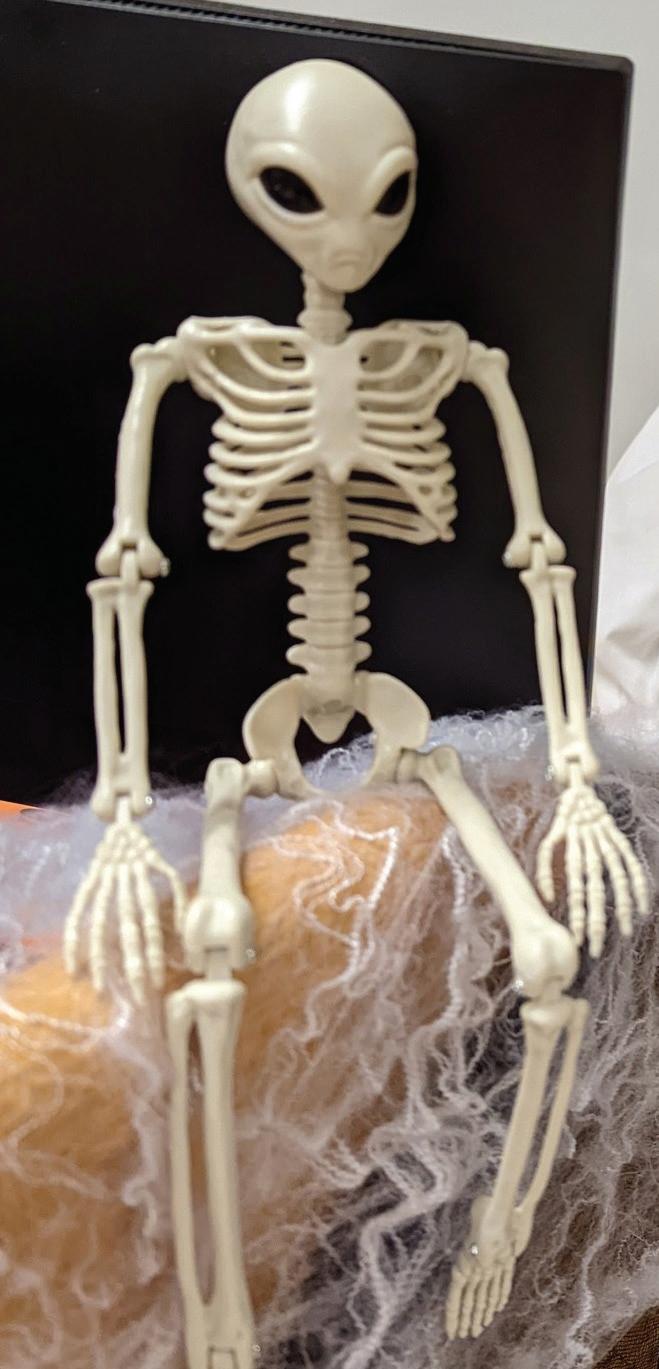
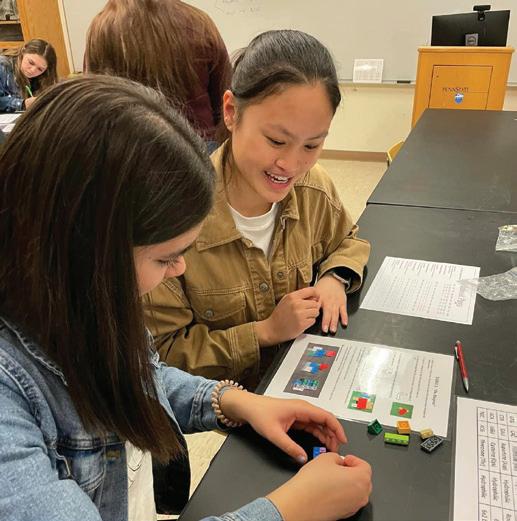
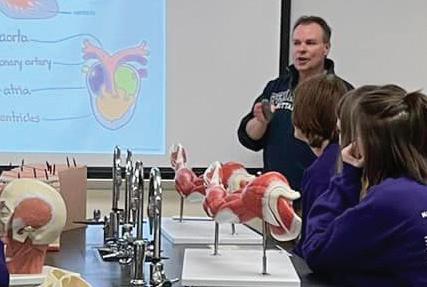
The Cardboard Boat Race challenged high-school and college students to construct boats using only cardboard and duct tape, then race them across the Junker Center pool against other teams. Vessels could not be motorized in any way, pushed or pulled by a swimmer, or sealed with any paints, adhesives, glues, or sealants. Fifteen teams participated in the event, which was spearheaded by Maarten Van Hees, lecturer in physics. The winning team used a surfboard design.
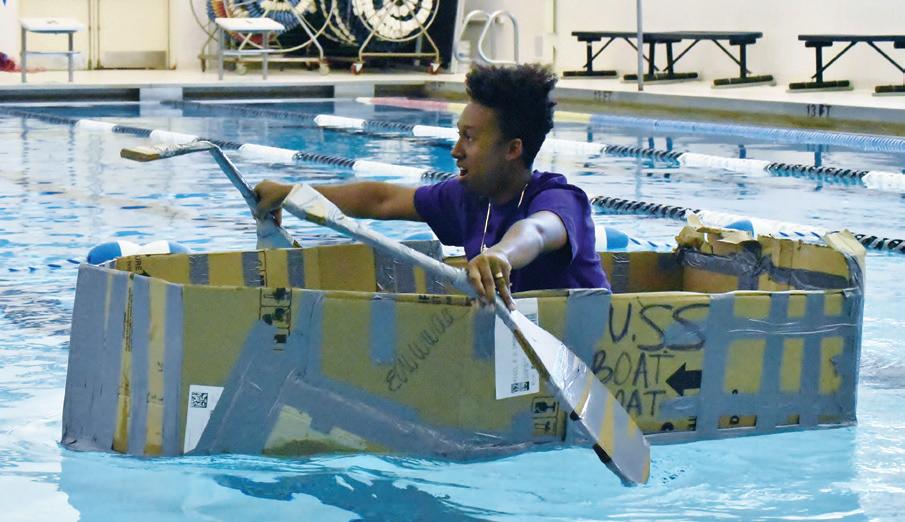
9
POP QUIZ, PROF!
School of Science faculty members answer burning science questions.
GRIZZLY VS. GORILLA
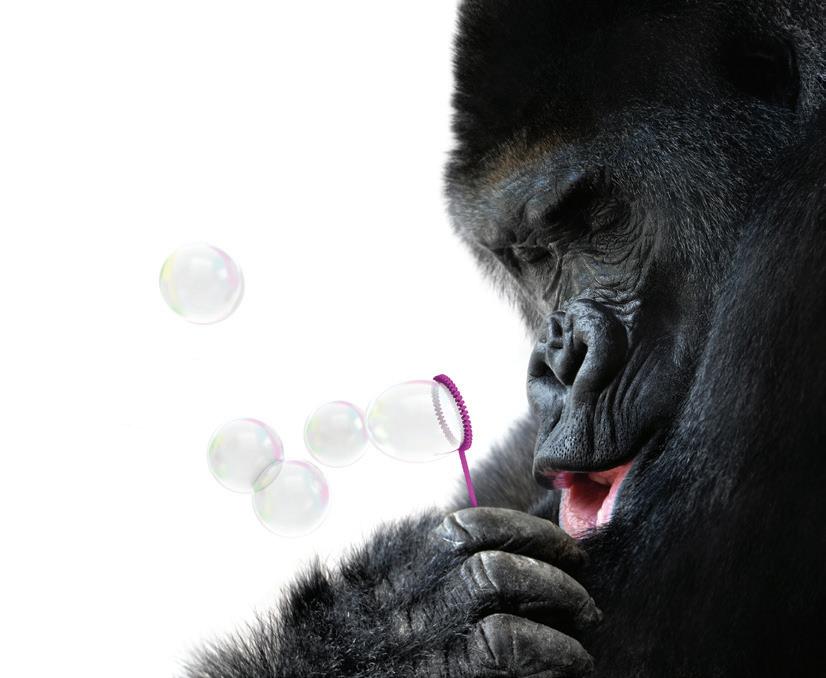
Who would win a fight between a grizzly bear and a

My money would be on the grizzly bear. Although gorillas are quite formidable with their opposable thumbs, strong bite force, capacity for tool use, and strength relative to their size, grizzly bears are better suited to taking down large prey. They are equipped with large claws, powerful forelimbs, surprising speed (running up to 35 m.p.h. over short distances), and an impressive bite force, which makes them excellent predators when the situation calls for it. Therefore, if a grizzly bear and a silverback gorilla were ever to meet and have a beef, my bet would be on the grizzly bear coming out on top, although it may sustain a few bumps and bruises from the battle. All I know for sure, however, is that if I were ever to encounter either in the wild, I will be heading in the opposite direction as quickly as possible to find a new pair of pants.
BIOLOGY
What is the most common element in the human body?
The short answer is oxygen. This is not due to the oxygen we breathe but because we are made up of 55 to 60 percent water, and this results in oxygen being the largest element in the human body at 65 percent by mass. The other three most abundant elements in the human body are carbon at less than 19 percent, hydrogen at less than 10 percent, and nitrogen at less than 4 percent. The human body also contains calcium and phosphorous at around 1 percent each and then sulfur, sodium, chlorine, magnesium, and several other elements at values less than 1 percent.
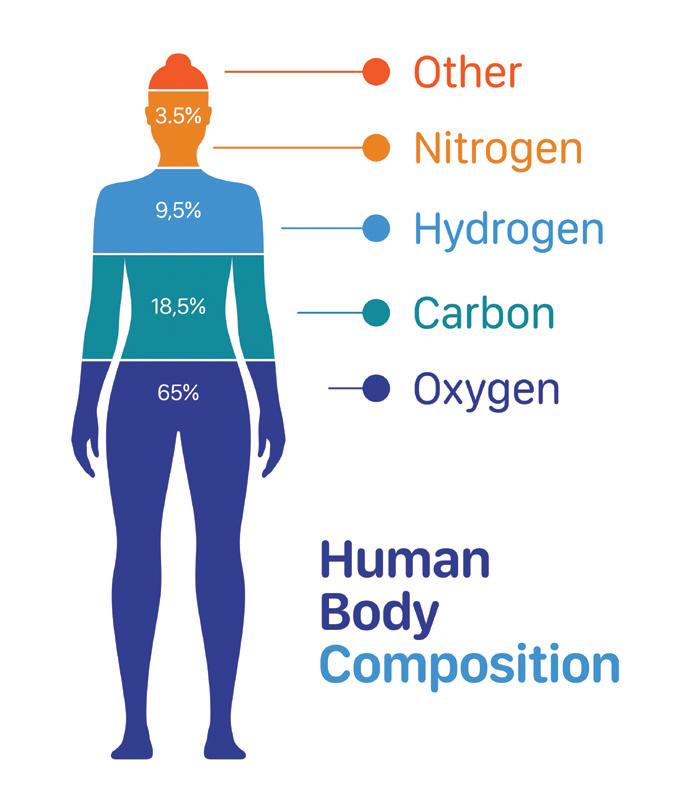 —DR. JAY AMICANGELO, PROFESSOR OF CHEMISTRY
—DR. JAY AMICANGELO, PROFESSOR OF CHEMISTRY
What purpose do mosquitoes have in the world?

This is a good question but let’s be honest: We share a biased perspective on these blood-sucking critters. And by “we,” I mean virtually ALL animals with a functioning circulatory system. From an ecological standpoint, mosquitoes play several important roles within the food chain. Like many other insects, mosquitoes have a complex life cycle that involves complete metamorphosis. Mosquitoes begin their lives as aquatic larvae, which develop underwater for approximately two weeks before emerging as flying adults. An adult female can lay hundreds of eggs in her lifetime, which means that mosquito larvae can reach high densities, especially in shallow waterbodies. Mosquito eggs that fail to hatch during the summer can overwinter until the following spring when rain returns; consequently, mosquito larvae are often the first abundant food source available for other animals during this period of scarcity. Additionally, adult male mosquitoes feed strictly on the nectar of plants and thus share the same purpose as other pollinators. Just as beauty is in the eye of the beholder, “purpose” is a matter of perspective. Try to keep an open mind when considering these less-than-charming organisms!
—DR. ADAM SIMPSON, ASSISTANT TEACHING PROFESSOR OF BIOLOGY
10
—DR. SAMUEL NUTILE, ASSISTANT PROFESSOR OF
What is the most endangered animal on earth right now?
This is a complicated question. Determining if a species is truly extinct is challenging, as death is rarely observed in nature, and dead bodies often do not last long because of decay or consumption. Moreover, many animals are elusive. There could be fewer than ten individuals of a particular species left in the wild, and we may never definitively find evidence that they are present. Recent controversies over the ivory-billed woodpecker and Tasmanian tiger exemplify this challenge.
To build on that, certain species are considered “extinct in the wild.” That is, they no longer exist as self-sustaining populations in their native habitat and are only propagated in captivity. These species are no longer able to fill the role they once played in their environment, even though they may have a moderate population size.
So, while there are many species that we don’t have population size estimates for, one species with a particularly small population size is the Javan rhinoceros. There are fewer than eighteen of these animals remaining. Javan rhinos are considered “critically endangered.”
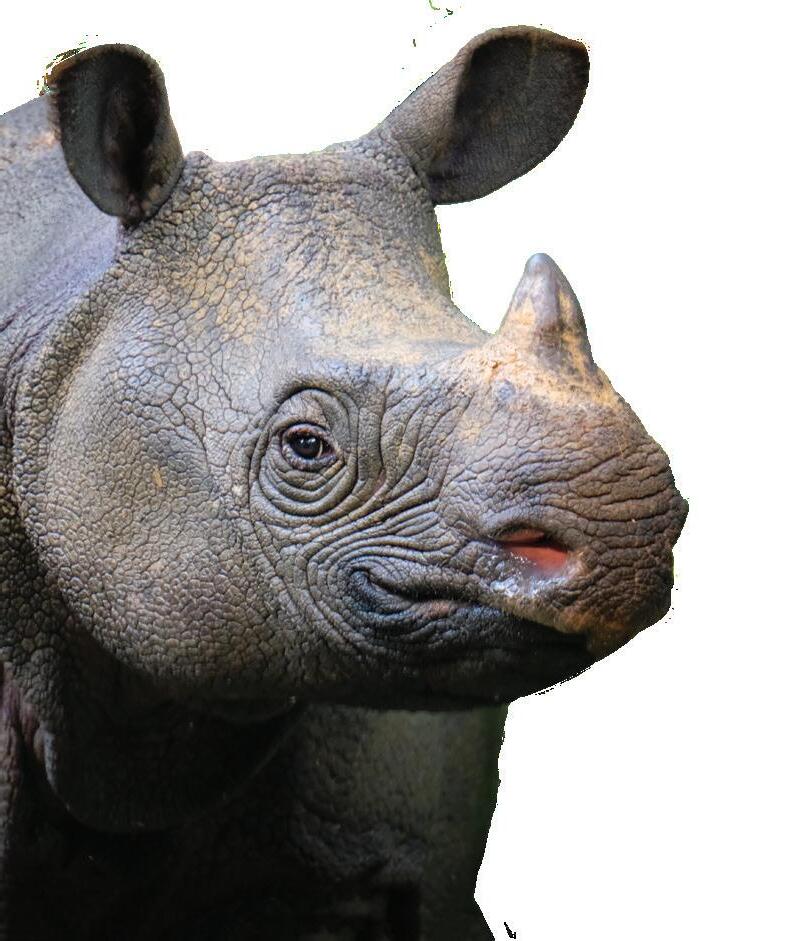
For more on which species are “extinct in the wild,” “critically endangered,” or “data deficient,” see the “red list” kept by the International Union for the Conservation of Nature at iucnredlist.org.
How do amphibians know it’s time to breed when the weather is so unpredictable?
Amphibian species vary in the exact cues that initiate their spring migration, but most rely on a combination of precipitation and rising average temperatures. Some amphibians, however, have a certain temperature threshold that needs to be hit for them to move or will move primarily during certain phases of the moon.
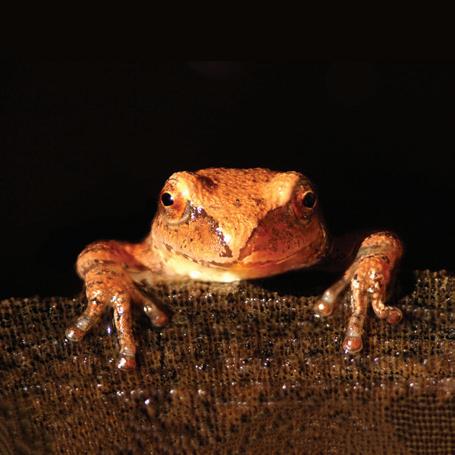 —DR. LYNNE BEATY, ASSISTANT PROFESSOR OF BIOLOGY
—DR. LYNNE BEATY, ASSISTANT PROFESSOR OF BIOLOGY
Can you light a diamond on fire?
Who invented Algebra and why?

Algebra was born of the need to solve problems and perform calculations even in everyday life. So, as many human endeavors that go through several iterations and growth, the field of science that we know as “algebra” does not have an inventor. But the origin of this word is well-known. The Persian mathematician Mohammed ibn Musa al-Khwarizmi wrote the treaty “al-Kitāb al-mukhtasar fīhisāb al-jabr walmuqābala” (The Compendious Book on Calculation by Completion and Balancing, in Arabic). When his work was studied in Europe, the expression “al-jabr” (balancing or restoring) became “algebra.” Also, as scholars kept repeating (in Latin) “and so said al-Khwarizmi” to justify the procedures they used, the word “algorithm” was born.
—DR. ANTONELLA CUPILLARI, ASSOCIATE PROFESSOR EMERITA OF MATHEMATICS
Absolutely. A 2009 article by Theodore Gray that appeared in Popular Science says it best. “It is bond strength, not hardness, that determines how easily oxygen can attack and burn a material.” Diamonds are carbon in a unique geometric structure, but the chemical composition is the same as graphite found in a common pencil. No one wants a fake diamond for their engagement ring, but it would withstand the heat. Diamonds, man-made or naturally occurring, are made of carbon (C) with minor impurities that add to the color quality. Cubic zirconia (CZ) are made of pure zirconium dioxide (ZrO2 ). Gray says “If your house burns down with the family jewels inside, you can collect the pools of melted gold, but the diamonds will be gone in a puff of CO2. Cheaper, more attractive stones, such as cubic zirconia and synthetic ruby and sapphire, are made of refractory metal oxides that easily withstand the same heat. So, it’s actually mall trinkets, not diamonds, that are forever.”
 —TRACY HALMI, ASSOCIATE TEACHING PROFESSOR OF CHEMISTRY
—TRACY HALMI, ASSOCIATE TEACHING PROFESSOR OF CHEMISTRY
11
—DR. LYNNE BEATY, ASSISTANT PROFESSOR OF BIOLOGY
School of Science
1 Prischak Building 4205 College Drive
Erie, PA 16563-0203
SAVE THE DATE
Parents, Families and Alumni Weekend is scheduled for September 29 through October 1 at Penn State Behrend. Once again, the School of Science will host a happy hour event just for alumni of the school.


On April 8, 2024, Erie will be in the path of totality for a solar eclipse. The School of Science anticipates eager eclipse watchers will flock to campus for the event, and the school is making plans to celebrate, educate visitors, and welcome this spotlight on Erie and Behrend.

regard

12
Non-Profit Org. U.S. POSTAGE PAID Erie, PA Permit No. 282 Science News is published annually and provided free to alumni and friends of the Penn State Behrend School of Science by the Office of Strategic Communications, William V. Gonda, wvg2@psu.edu, senior director. Editor: Heather Cass, hjc13@psu.edu. Designer: Martha Ansley Campbell, mac30@psu.edu. This publication is available in alternative media on request. Penn State is an equal opportunity, affirmative action employer, and is committed to providing employment opportunities to all qualified applicants without
to race, color, religion, age, sex, sexual orientation, gender identity, national origin, disability or protected veteran status. U.Ed. EBO 23-280
Penn State Erie, The Behrend College





 DR. MARTY KOCIOLEK
ON THE COVER : Students in BIOL 164 Human Anatomy and Physiology examine a cadaver on one of Behrend’s new Anatomage virtual dissection tables.
DR. MARTY KOCIOLEK
ON THE COVER : Students in BIOL 164 Human Anatomy and Physiology examine a cadaver on one of Behrend’s new Anatomage virtual dissection tables.









 —DR. TODD COOK, ASSOCIATE PROFESSOR OF BIOLOGY
—DR. TODD COOK, ASSOCIATE PROFESSOR OF BIOLOGY










 —DR. JAY AMICANGELO, PROFESSOR OF CHEMISTRY
—DR. JAY AMICANGELO, PROFESSOR OF CHEMISTRY


 —DR. LYNNE BEATY, ASSISTANT PROFESSOR OF BIOLOGY
—DR. LYNNE BEATY, ASSISTANT PROFESSOR OF BIOLOGY

 —TRACY HALMI, ASSOCIATE TEACHING PROFESSOR OF CHEMISTRY
—TRACY HALMI, ASSOCIATE TEACHING PROFESSOR OF CHEMISTRY









